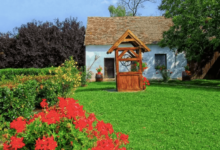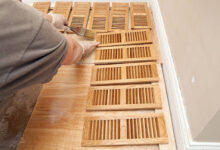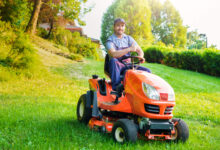A lush healthy green, vibrant lawn is every homeowner’s dream. It accentuates the beauty of the landscape and makes the building stand out on the block. Maintaining a healthy lawn needs little work and ultimately benefits the owner later on.
The following are tips on how to grow a healthy lawn:
- Start with preparing the area for planting: clean out old grass and weeds, inspect soil type and pick the grass of your choice, this is if you have not had your grass installed yet.
- Continuous Mowing: mow to a height of 6 to 8 centimeters (2.5 to 3 inches). This is the recommended mowing height and it helps break soil erosion, promote growth and gives the perfect aesthetic touch. The blades on the lawnmower should be sharpened to cut grace nice and easy. A reel mower is said to be preferable to the traditional mower because of its scissors cutting pattern but do not know after a week of installing new grass or on wet grass.
- Ensure proper watering: Water deeply but not too often! Overwatering hinders growth of deep roots and causes leaching of plant nutrients. Experts recommend that you water your grass with 1 inch (2.54 cm) of water, once a week. An electronic soil tester can be used to test soil moisture and know when to spray again. The manual method is rubbing the first 4 inches of the soil between your fingers and if dry, apply water again. Water early in the morning or late at night.
- Opt for natural fertilizers instead of the synthetic variant: They are better for the lawn, family, and the environment at large. You can use a fertilizer spreader for application and follow the instructions for application. 3-4 times during a growing season is enough and not more than that.
- Apply Compost: Like all living organisms, feed your lawn so that it can grow. Compost should be thoroughly decomposed however to prevent pathogens.
- Try Grass cycling: After mowing your lawn, leaving the clipped grass and allowing the lawn to reuse it is called grass cycling. The benefit of grass cycling is that it can serve as compost material returning nutrients back to the soil, help to retain moisture, saves time of having to pack out the clipped grass, and reduces the need for fertilizer.
- Inspect your lawn often: run a routine inspections on your lawn. This is to check for pests and other problems so that it can be tackled early. Also use Mulch or paving stone in places that have a lot of traffic.
- Aerate your lawn: Lawn aeration simply means giving your lawn room to breathe by punching holes of about 3 inches (ca. 8 cm) deep. With constant traffic over lawn areas later on the soil around those areas can become compacted making the soil lose its proper circulation channels for both water and air. Insects that help with soil health such as earthworm cannot move feeling around in compacted soil. Aerating should be done once a year and can either be done by a large aerating machine or a handheld tool.
- Fight weeds and pests: proper lawn care should prevent their growth but if any opt for a pulling method for weeds rather than chemical sprays. Pesticides should be used cautiously taking great care to protect the person spraying it as it can be dangerous to humans.
- Prevent Thatch buildup: The spongy layer of brown material atop the soil is called thatch. It can cause issues if allowed growing past 0.5 inch (1.25 cm) thick.
For more tips on growing lawns and what fertilizer to use, check out this guide.
Benefits of having a healthy lawn
The importance of having a healthy lawn are numerous and should spur you on taking good care of your lawn:
- Helps to control soil erosion: Grass and grassroots helps to prevent small scale erosion by acting as water breakers.
- Increases soil health: The grass clippings after mowing increases soil health when the decompost and a healthy lawn creates a balanced ecosystem for beneficial soil organisms.
- Increases oxygen production: There is increase in oxygen production alongside reduction of CO2 and filtering of smoke and other pollutants by Turf grass.
- Improves your home outlook: The aesthetics a healthy lawn gives can boost your home value in case of a sale.



